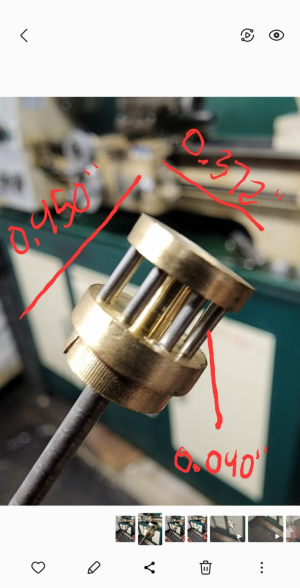- Joined
- Mar 2, 2018
- Messages
- 232
My second attempt at making a lantern pinion was almost a success. The part was guaranteed to be bad, because the parting tool grabbed, and snapped it off prematurely, but I continued anyway as a practice run. I moved the Y axis out 0.129" with my DRO to drill a 0.258" bolt circle with a #60 drill, before installing 0.040" music wire for the lantern doodads. I forgot what the lantern doodads are called. It's not bad for a second try, but I have the following problems:
The #60 holes seem to be slanted. Not shocking that such a tiny bit deflected, but what to do about it? I ran the mill in low gear at about 100 rpm, and fed very slowly with the fine feed knob.
I probably had a work holding problem. I ran a DTI over the top of the part while it was in the chuck on the rotary table, and it was about 0.030" high on one side. Not sure how I can solve that, but as I write this, it seems obvious that this is probably causing the slant I detected. The only surface I can grip is only 0.080" wide. Maybe I need to sacrifice concentricity, drill this on the lathe, and make some kind of arbor that I can grip more positively in the chuck. (Or swap to the collet chuck or the 4-jaw so I don't have to sacrifice concentricity.) It could just be a crappy scroll chuck. I don't even remember where I bought a rotary table with a weird 4-jaw scroll chuck. I took the chuck apart and went through it, and it's as good as it can be, but it's not a good chuck. It's an okay chuck at best.
The #43 hole in the center is off-center. Made two of these, and had that problem both times. My 0 setting has to be damn close, because my pin holes are coming out the same distance from the edge all the way around. I don't see any way I could drill a perfect circle relative to the part, and wind up with the center hole dramatically far off twice in a row. Bit deflecting again? A #43 drill is not very stiff.
Anyway, here's the picture. I think it's kind of cool how you can see the witness marks of the parting tool chattering and catching. That little high spot there is what snapped the part right off before I had hit the target diameter:

The #60 holes seem to be slanted. Not shocking that such a tiny bit deflected, but what to do about it? I ran the mill in low gear at about 100 rpm, and fed very slowly with the fine feed knob.
I probably had a work holding problem. I ran a DTI over the top of the part while it was in the chuck on the rotary table, and it was about 0.030" high on one side. Not sure how I can solve that, but as I write this, it seems obvious that this is probably causing the slant I detected. The only surface I can grip is only 0.080" wide. Maybe I need to sacrifice concentricity, drill this on the lathe, and make some kind of arbor that I can grip more positively in the chuck. (Or swap to the collet chuck or the 4-jaw so I don't have to sacrifice concentricity.) It could just be a crappy scroll chuck. I don't even remember where I bought a rotary table with a weird 4-jaw scroll chuck. I took the chuck apart and went through it, and it's as good as it can be, but it's not a good chuck. It's an okay chuck at best.
The #43 hole in the center is off-center. Made two of these, and had that problem both times. My 0 setting has to be damn close, because my pin holes are coming out the same distance from the edge all the way around. I don't see any way I could drill a perfect circle relative to the part, and wind up with the center hole dramatically far off twice in a row. Bit deflecting again? A #43 drill is not very stiff.
Anyway, here's the picture. I think it's kind of cool how you can see the witness marks of the parting tool chattering and catching. That little high spot there is what snapped the part right off before I had hit the target diameter:


